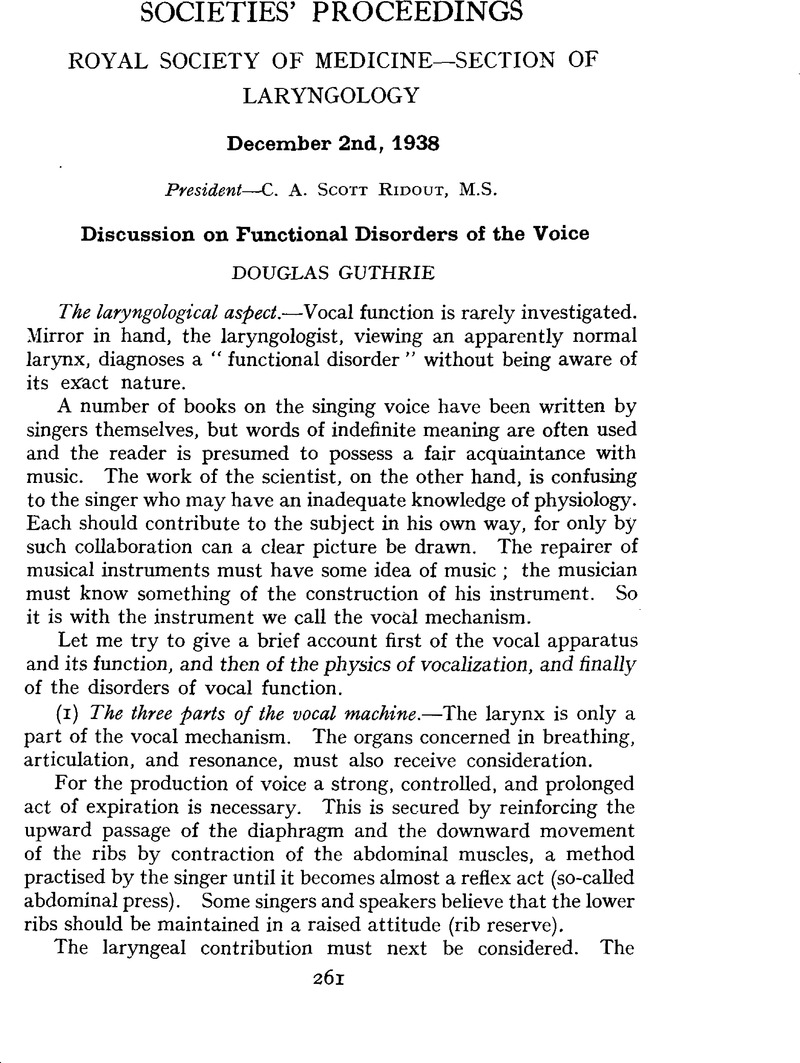No CrossRef data available.
Article contents
Royal Society of Medicine—Section of Laryngology
Published online by Cambridge University Press: 29 June 2007
Abstract
An abstract is not available for this content so a preview has been provided. Please use the Get access link above for information on how to access this content.

- Type
- Societies' Proceedings
- Information
- Copyright
- Copyright © JLO (1984) Limited 1939
References
Ashcroft, D. W., Hallpike, C. S., and Rawdon-Smith, A. F. (1937), “On the Changes in Histological Structure and Electrical Response of the Cochlea of the Cat following Section of the Eighth Nerve,” Proc. Roy. Soc., London, B., cxxii, 186.Google Scholar
Davis, H. (1935), “The Electrical Phenomena of the Cochlea and the Auditory Nerve,” J. Acoust. Soc. Am., vi, 205.Google Scholar
Davis, H.Derbyshire, A. J., Lurie, M. H., and Saul, L. J. (1935), “The Electric Response of the Cochlea,” Am. J. Physiol., cvii, 311.Google Scholar
Derbyshire, A. J., and Davis, H. (1935), “The Action Potentials of the Auditory Nerve,” Am. J. Physiol., cxiii, 476.Google Scholar
Hallpire, C. S., and Rawdon-Smith, A. F. (1934 a), “The Origin of the Wever and Bray Phenomenon,” J. Physiol., lxxxiii, 2, 243.CrossRefGoogle Scholar
Hallpire, C. S. (1934 b), “The Function of the Tensor Tympani Muscle,” J. Physiol., lxxxi, 25 P.Google Scholar
Hallpire, C. S. (1937), “The Wever and Bray Phenomenon—A Summary of the Data Concerning the Origin of the Cochlear Effect,” Ann. Otol., Rhin. and Laryng., xlvi, 976.Google Scholar
Newman, E. B., Stevens, S. S., and Davis, H. (1937), “Factors in the Production of Aural Harmonics and Combination Tones,” J. Acoust. Soc. Am., ix, 107.Google Scholar
Rawoon-Smith, A. F. (1938), “Theories of Sensation.” Section II— “Audition,” Cambridge University Press.Google Scholar
Rawoon-Smith, A. F. (1939), “Recent Progress in the Study of the Auditory Mechanism,” Bull. Anim. Behav. (in press).Google Scholar
Stevens, S. S., and Davis, H. (1938), “Hearing; its Psychology and Physiology.” New York, Wiley.Google Scholar
Wever, E. G., and Bray, C. W. (1930 a), “Action Currents in the Auditory Nerve in Response to Acoustical Stimulation,” Proc. Nat. A cad. Sc., Washington, xvi, 344.Google Scholar
Wever, E. G., and Bray, C. W. (1930 b), “The Nature of Acoustic Response: The Relation Between Sound Frequency and Frequency of Impulses in the Auditory Nerve,” J. Exper. Psychol., xiii, 373.CrossRefGoogle Scholar
Wever, E. G. (1938), “Distortion in the Ear as Shown by the Electrical Responses of the Cochlea,” J. Acoust. Soc. Am., ix, 227.Google Scholar


